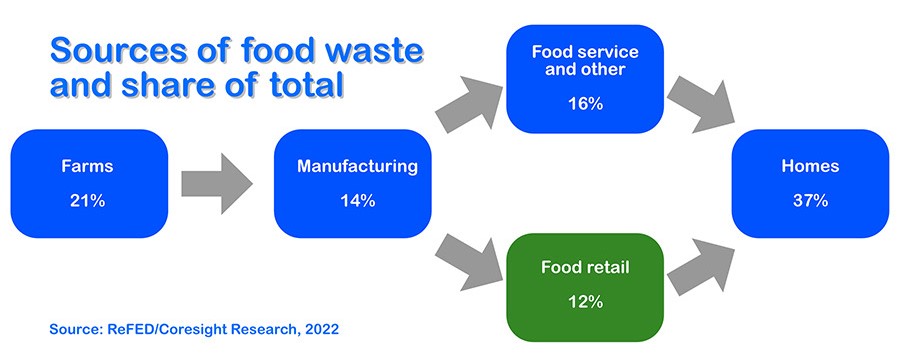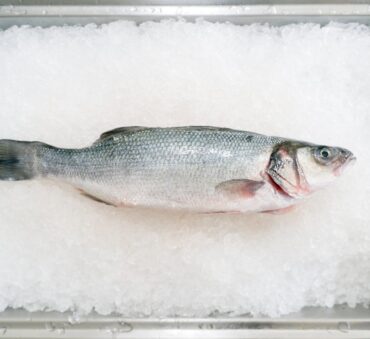The problem of food waste: what causes it and how to minimize it?
The problem of food waste is a global issue that silently yet relentlessly contributes to environmental degradation, economic losses, and social inequalities. In the United States alone, around 40% of the food supply doesn’t make it to our plates and often ends up as waste destined for landfills. If we zoom out to a global scale, the magnitude of the issue becomes almost inconceivable, with reports estimating a monumental 2.5 billion tons of food is wasted annually.
The problem of food waste isn’t merely a matter of lost calories; it signifies wasted resources such as water, energy, land, labor, and capital. Moreover, it contributes to 8-10% of total global greenhouse gas emissions.
In this article, we explore what food waste is, its causes, its consequences, and the strategies to mitigate it.
What is food waste?
Food waste refers to the loss in quality or quantity of food due to actions and decisions made by retailers, food service providers, and consumers. It encompasses the edible items we let spoil at home, the uneaten leftovers at restaurants, and the surplus goods that fail to find takers in grocery stores.
It’s worth noting that food waste should not be confused with food security. While food waste revolves around the mismanagement and disposal of surplus food, food security deals with the availability and accessibility of food to all individuals at all times. The ironic contrast between the two is hard to miss: while we waste massive amounts of food, nearly 690 million people worldwide still go to bed hungry.
What causes food waste?
Several factors contribute to food waste, from agricultural production to consumer behavior. These issues are intricately tied to our current food systems, capitalism, and societal attitudes toward food. The following sections examine specific sources of food waste, unveiling the extent of the problem in various sectors.
Food waste in restaurants
Restaurant food waste typically arises from three primary sources:
- over-preparation of dishes
- large portion sizes
- inflexible menus
Over-preparation, often a result of wanting to meet customer demand promptly, leads to substantial quantities of food being thrown away at the end of the day.
Large portion sizes, typically influenced by the notion of ‘value for money’, result in uneaten food being left on plates and subsequently discarded.
Lastly, inflexible menus, where alterations to dishes are not permitted, can lead to unwanted ingredients being left uneaten and ultimately wasted.
Food waste in schools
Schools are another significant contributor to food waste, often due to strict regulations regarding the nutritional content and portion sizes of meals. These regulations can sometimes lead to the provision of foods that many students may not eat, resulting in substantial food waste in schools.
Furthermore, since the school day is tightly scheduled, students often don’t have enough time to finish their meals.
Household food waste
At a household level, food waste is largely driven by consumer behavior, including buying and cooking habits. Over-purchasing, particularly when sales or promotions are in play, often leads to more food than can be consumed before it is spoiled.
Moreover, confusion around “best-by” and “use-by” labels can cause perfectly good food to be thrown away.
Grocery store food waste
Supermarkets and grocery stores contribute to food waste in several ways. Retailers often overstock displays to maintain an image of abundance, and any unsold items past their display date are typically discarded.
Cosmetic standards also play a part, with ‘ugly’ fruits and vegetables waste—those that are perfectly good to eat but don’t meet the aesthetic standards—often rejected and thrown away.
Food waste in farms
At the very beginning of the food supply chain, food waste can occur for a multitude of reasons, including market conditions, appearance standards, and labor costs.
To protect themselves against possible crop losses, farmers frequently produce more than they can sell. This leads to a surplus, hence, more farm waste. Strict appearance standards imposed by retailers can mean ‘ugly’ but perfectly good produce is left in the field.
Additionally, market prices and demand also influence a harvest decision. If the cost of labor outweighs the potential return, it may, sadly, be more economical to just not harvest.
Food waste in manufacturing facilities
Food waste in manufacturing facilities typically occurs due to inefficiencies and inaccuracies in the production process. Technical malfunctions, human error, or overproduction caused by forecasting inaccuracies can result in surplus food that can’t be stored or sold in time.
Distribution retail food waste
In the distribution phase, food waste results from logistical issues like transportation delays, poor handling, and incorrect storage conditions.
Long supply chains with many intermediaries increase the risk of food spoiling before it reaches the end consumer. Additionally, unexpected changes in demand can lead to overstocking or understocking, both of which can result in food waste.

Food waste statistics
Putting the global and US food waste problems into numbers further paints a sobering picture.
- Roughly one-third of all food intended for human consumption worldwide is wasted. [Source]
- The financial loss due to food waste is substantial, with the global value of food waste estimated to be around US$1 trillion per year. [Source].
- If 25% of the food currently being lost or wasted globally was saved, it would be enough to feed 870 million people around the world. [Source].
- About 6%-8% of all human-caused greenhouse gas emissions could be reduced if we stop wasting food. [Source]
- Food waste is the number one material in US landfills, accounting for 24% of all municipal solid waste. [Source].
- The global carbon footprint of food loss and waste is estimated to be 3.3 billion tons of CO2 equivalent. [Source]
- The distribution of this waste shows that 61% comes from households, 26% from food services, and 13% from retail establishments. [Source]
Effects of food waste
The Environmental Consequences
Climate Change: The Carbon Footprint of Wasted Food
Food production is a high-energy, resource-intensive process that, when wasted, translates to a significant amount of greenhouse gas emissions. In other words, food waste affects the environment in a bad way.
From production to transportation, food’s lifecycle is a carbon-intensive process. But when this food ends up in landfills, the issue compounds. As it decomposes, it releases methane, which has a warming potential 25 times greater than carbon dioxide. In this way, food waste plays a substantial role in exacerbating climate change.
Biodiversity Loss
Wasting food is akin to wasting nature. The impact of food waste on biodiversity is twofold. Firstly, intensive agriculture practices, driven by high demand and wastage, lead to habitat destruction. These practices clear forests and grasslands, creating monocultures and decimating local biodiversity.
Secondly, rotting food waste in landfills generates harmful leachate. This toxic liquid can contaminate surrounding soil and groundwater, disrupting local ecosystems and harming plant and animal life.
The Economic Ramifications
The financial impact of food waste is nothing short of colossal, reaching well into the trillions of dollars. However, this predicament doesn’t exclusively plague large-scale producers or retailers but also trickles down to individual households too, where the average family discards up to a third of the food they purchase.
The sheer magnitude of food waste globally represents an enormous economic drain. When food is discarded, the resources spent on its production, including water, land, energy, labor, and capital, are also wasted. Not to mention the cost of managing food waste, which is both financially taxing and environmentally harmful as much of it ends up in landfills for composting. Therefore, by wasting food, we are essentially wasting money, and the scale of this waste is large enough to have significant macroeconomic implications.
The Social Implications
The social implications of food waste are heavily intertwined with issues of social justice and equity. When we discard edible food, we are not just wasting valuable resources; we’re exacerbating the deep-seated problem of food insecurity that affects millions around the globe.
By understanding this link, we start to see that our kitchen habits have broader implications than we might have initially thought. While you might see an overripe banana or some stale bread, others see a missed opportunity to feed those in need. The stark reality is that while we waste one-third of the world’s food, approximately 828 million people suffer from chronic hunger. This discrepancy is a clear indication of a social system that needs urgent reform.
Solutions to the problem of food waste
The issue of food waste is indeed a mammoth problem to fix; however, it is not an impossible one. There are numerous ways we can tackle it, from individual actions to systemic changes. Promoting better food storage and preservation techniques, enhancing supply chain efficiencies, changing consumer behavior, and implementing efficient waste management and food recovery operations can all contribute to significant reductions in food waste.
Shapiro’s services, offer customised food waste recycling & upcycling solution, helping businesses and industries navigate the challenge of minimizing food waste
FAQ’s on Food Waste
What is the role of organic waste recycling management companies?
Companies like Shapiro offer innovative solutions for food waste management. This contributes significantly to the creation of a more sustainable food system.
Why is food waste a significant issue?
Food waste is a pressing global issue due to its adverse economic, environmental, and social implications. It squanders valuable resources, including water, energy, and land, required for food production. Additionally, it contributes to greenhouse gas emissions, exacerbates food insecurity, and perpetuates social inequality.
What are the main causes of food waste?
Food waste can occur at various stages of the supply chain. The main causes include inadequate harvesting techniques, poor storage and transportation infrastructure, inefficient processing and packaging practices, market fluctuations, and consumer behavior, such as overbuying, improper storage, or discarding edible food.
What are the benefits of reducing food waste?
Reducing food waste has many benefits. It conserves natural resources, reduces greenhouse gas emissions, protects biodiversity, and helps alleviate hunger and food insecurity. Additionally, it presents economic opportunities and promotes a circular economy. Not to mention that it cultivates a more sustainable and equitable food system for future generations.
Baily Ramsey, an accomplished marketing specialist, brings a unique blend of anthropological insight and marketing finesse to the digital landscape. Specializing in educational content creation, she creates content for various industries, with a particular interest in environmental initiatives.



